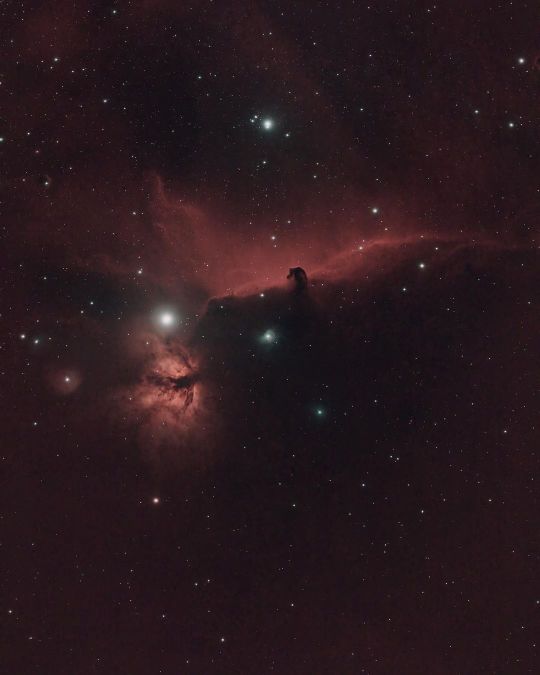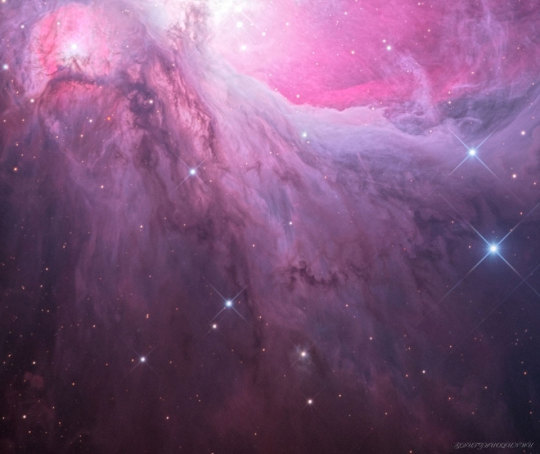#orionmolecularcloudcomplex
Explore tagged Tumblr posts
Photo

Thé Horsehead Nebula appears as a dark silhouette in the vast Orion Molecular Cloud Complex behind it. It is too faint to see without a telescope. It was first identified by the Scottish astronomer Williamina Fleming in 1888. The deep red colour is caused by the ionized hydrogen that dominates this area. It is about 1,400 light-years away. This image is a composite of 54 photos, where each is a 3 minute exposure. I used an special filter to highlight the ionized hydrogen. I captured this image from my balcony in Strasbourg France in early February 2023. #horseheadnebula #barnard33 #ngc2023 #orionmolecularcloudcomplex #orionbelt #astronomy #astrophotography #astronomiefrance #astropgotographie (at Strasbourg, France) https://www.instagram.com/p/Coh7ppvstFv/?igshid=NGJjMDIxMWI=
#horseheadnebula#barnard33#ngc2023#orionmolecularcloudcomplex#orionbelt#astronomy#astrophotography#astronomiefrance#astropgotographie
31 notes
·
View notes
Text

COSMIC WATERFALL IN THE BACKYARD OF THE MASTER OF THE UNIVERSE.
PIC INFO: Spotlight on M43, a.k.a., Orion Falls. 📸+🔭: Zhuoqun Wu, Chilescope Telescope 2, c. 2018.
OVERVIEW: "Is there a waterfall in Orion? No, but some of the dust in M43 appears similar to a waterfall on Earth. M43, part of the Orion Molecular Cloud Complex, is the often imaged but rarely mentioned neighbor of the more famous M42. M42, which includes many bright stars from the Trapezium cluster, lies above the featured scene.
PART II: M43 is itself a star forming region and although laced with filaments of dark dust, is composed mostly of glowing hydrogen. The entire Orion field, located about 1600 light years away, is inundated with many intricate and picturesque filaments of dust. Opaque to visible light, dark dust is created in the outer atmosphere of massive cool stars and expelled by a strong outer wind of protons and electrons."
-- APOD (Astronomy Picture of the Day), published December 12, 2018
Source: https://apod.nasa.gov/apod/ap181212.html.
#OrionFalls#CosmicWaterfall#APOD#AstronomyPictureoftheDay#Astronomy#M43#OrionMolecularCloudComplex#Trapezium#TrapeziumCluster#Stars#OrionField#DarkDust#Pink#Pinkcore#Space#SpaceisDeep#M43 Orion Falls#M43OrionFalls#Astrophotography#🌌#TheUniverse#TheCosmos#Cosmos#🔭
2 notes
·
View notes
Photo

Part of the Orion Molecular Cloud Complex, which is found in the constellation of Orion, is a massive and one of the most active stellar forming regions visible in the night sky. Of note in this image is Barnard’s Loop (sh2-276), an emission nebula which covers 10 degrees in the sky. Thought to lie some 518 light years [ly] or 1434 ly away. Enclosed by it you can see the Horsehead (B33) and Flame Nebula (ngc2024), as well as the bright nebula (ic434) around B33, as well as the Orion Nebula (M42). Near the edge of the frame in the top right the witch head reflection nebula is also visible. This was shot in Mersing on 9th March 2019 with a Sony a7ii and a polarie with a zeiss batis 85mm. #orion #orionmolecularcloudcomplex #beltoforion #barnardsloop #flamenebula #horseheadnebula #orionnebula #witchheadnebula #sh2276 #sh2277 #ngc2024 #ic434 #barnard33 #messier42 #m42 #mersing #zeissbatis85 #alphacreates #alphacreatesstarscapes #polarievixen (at Srikandi Resort) https://www.instagram.com/p/Bu5fML6lWeY/?utm_source=ig_tumblr_share&igshid=1s3vgeotuagz4
#orion#orionmolecularcloudcomplex#beltoforion#barnardsloop#flamenebula#horseheadnebula#orionnebula#witchheadnebula#sh2276#sh2277#ngc2024#ic434#barnard33#messier42#m42#mersing#zeissbatis85#alphacreates#alphacreatesstarscapes#polarievixen
0 notes
Photo

The Flame Nebula, is a hot glowing cloud in the Belt of Orion constellation. The bright star in the foreground is flooding the region with ultraviolet light, and that energizes the Frame Nebula. The Flame Nebula is part of the vast Orion Molecular Cloud Complex which fills the southern sky on a midwinter evening, but is too faint for casual observation. At 900 light years distance, it is very close on a galactic scale. If it were a large city, we would be living in its suburbs. I photographed the Flame Nebula from my balcony in Strasbourg France, February 2022. #flamenebula #ngc2024 #sh2-277 #orionmolecularcloudcomplex #astronomy #astronomie #astrophotography #astrophotographie #astrophotographiefrance #poussieredetoile #poussièredétoiles (at Strasbourg, France) https://www.instagram.com/p/CZ9trlIsNXR/?utm_medium=tumblr
#flamenebula#ngc2024#sh2#orionmolecularcloudcomplex#astronomy#astronomie#astrophotography#astrophotographie#astrophotographiefrance#poussieredetoile#poussièredétoiles
0 notes